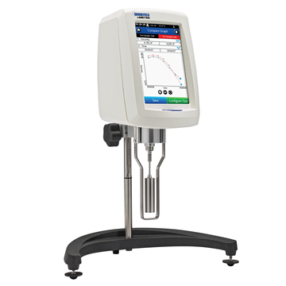Viscosity measurements are crucial for a variety of industries, ensuring quality and consistency in product development. After all, nobody wants their ketchup to be as runny as soup, right?
However, mistakes in these measurements can lead to inaccurate results and, ultimately, subpar product performance. Whether you’re new to using viscometers or looking to refine your technique, this guide will help you avoid common pitfalls and get the most accurate results.
In this post, we’ll explore how viscometers, like the popular Brookfield Viscometer, play a vital role in the process.
What Is a Viscometer and Why Is It Important?
A viscometer is an essential tool for measuring the viscosity of a fluid, which is its resistance to flow. Understanding how to use viscometers properly is key to ensuring accurate measurements, especially in industries like pharmaceuticals, food production, and cosmetics.
Viscometers Vs Rheometers:
“Ever wondered when to use a viscometer and when you might need a rheometer?
It’s like choosing between a basic toolkit and a high-tech gadget with all the bells and whistles. If you’re just checking if your honey flows like it should, a viscometer’s your go-to. But if you’re trying to figure out how your honey behaves when you’re shaking the jar and doing the “cha-cha”, that’s where a rheometer comes into play!”
Wikipedia
Here are some of the basics:
- Types of viscometers: Rotational viscometers (like the Brookfield Viscometer) and capillary viscometers are commonly used in laboratories.
- Why viscosity matters: Viscosity impacts the texture, stability, and performance of products such as creams, sauces, or paints.
- Applications: Viscometers are used across sectors to maintain product quality, especially in processes where consistency is critical.
Common Mistakes in Viscosity Measurements
When using a viscometer, it’s easy to make errors that lead to incorrect viscosity readings. Here are some of the most common mistakes and how you can avoid them:
- Incorrect sample preparation:Incorrect Sample Preparation: Ensure that your sample is free from bubbles and is well-mixed before measurement. We all know the excitement of seeing bubbles in our drinks, but not so much in our viscosity samples!.
- Using the wrong viscometer settings: Viscometers come with various settings for speed and spindle type. Choose the right combination based on the fluid you’re measuring.
- Inconsistent sample temperature: Viscosity is highly sensitive to temperature changes. Ensure that your sample is at a consistent and correct temperature before you start.
- Improper cleaning of the equipment: Residues from previous tests can contaminate your current sample, affecting results. Clean your viscometer thoroughly after each use.
- Inadequate calibration: Regular calibration of your viscometer ensures its readings are accurate. Make sure to follow the manufacturer’s instructions on how often to calibrate your device.
By avoiding these errors, you can improve the reliability of your viscosity measurements, leading to better quality control in your laboratory.
Brookfield Viscometer: A Trusted Tool in Viscometry

The Brookfield Viscometer is one of the most trusted tools in the field of viscometry. It’s widely used for its accuracy and versatility. Here’s why it’s a preferred choice:
- Ease of use: Ease of Use: Even beginners can quickly learn how to operate a Brookfield Viscometer. It’s so user-friendly that you might just feel like a lab superhero—cape not included.“
- Wide range of applications: From food production to pharmaceuticals, this viscometer is adaptable to various industries.
- Accuracy: The Brookfield Viscometer provides precise viscosity readings, even for complex fluids.
To get the most out of your Brookfield Viscometer, make sure to follow the proper procedures for calibration and measurement. This ensures the highest level of accuracy and repeatability.
Other Key Factors in Viscometry: Shear Rate and Time Dependence
Viscosity can change depending on the shear rate (how quickly the fluid is being stirred) and over time (for thixotropic fluids that thin out when stirred). It’s important to account for these variables when performing viscosity measurements:
- Shear rate: Make sure to set your viscometer to the correct speed, especially when measuring non-Newtonian fluids, which change viscosity under different shear rates.
- Time dependence: Some fluids require a specific amount of time to settle before accurate measurements can be taken. Pay attention to any time-related changes in viscosity.
Keeping these factors in mind when performing viscometry will ensure that your readings are accurate and reliable.
How to Choose the Right Viscometer for Your Needs
Choosing the right viscometer depends on the type of fluid you’re working with and the level of precision you require. Below are key considerations to guide your selection:
- Fluid Type:
The viscosity of your fluid is critical in choosing the right viscometer. For low-viscosity fluids, a Capillary Viscometer is an ideal choice as it measures the time it takes for the fluid to pass through a narrow tube. It’s like timing how fast your coffee cools down, but with much more scientific flair.If you’re working with higher-viscosity or non-Newtonian fluids, a Coaxial Double Cylindrical Rotational Viscometer or Cone Plate Viscometer may be more suitable due to their ability to handle more complex flow properties. - Required Accuracy:
If precision is essential, such as in industrial or research applications, consider viscometers known for high accuracy. The Cone Plate Viscometer excels in providing precise measurements for high-viscosity fluids, while Falling Ball Viscometers offer reliable readings for low to medium viscosity fluids. - Frequency of Use:
For frequent use, especially in environments where ease of use and durability are important, a Single Cylindrical Rotational Viscometer is a practical option due to its portability and ease of handling. It’s ideal for labs requiring moderate precision and quick measurements.
Understanding your specific fluid characteristics, accuracy needs, and usage frequency will help you choose the right viscometer, ensuring accurate and reliable results for your application.
Understanding and avoiding common pitfalls in viscosity measurement can significantly boost the quality and performance of your products. Whether you’re refining your technique or selecting the right viscometer for your needs, expert advice is just a click away.
Explore Our Catalogue: Dive deeper into the world of viscometers and find the perfect tool for your industry. Browse Now!
Need More Help? Reach out to us for personalised advice and support to ensure you get the most accurate results from your viscosity measurements. Contact Us Today!
Call us at 72888 88016 or email us at marketingsupport@smartlabtech.net

